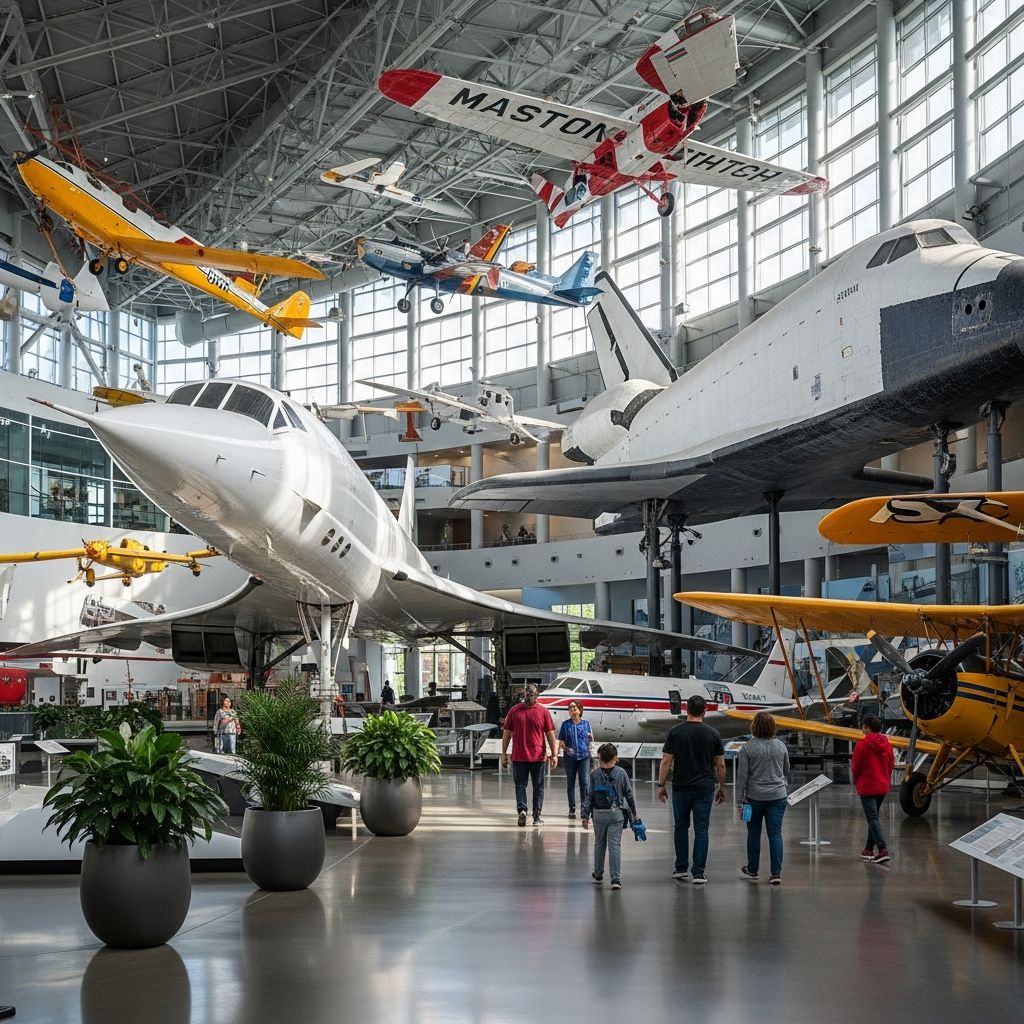The Museum of Flight: Charting the Course of Aviation in Seattle
Explore the past, present, and future of aviation and space at Seattle’s Museum of Flight—an inspiring journey for all ages.

Seattle’s Museum of Flight stands as the largest private, not-for-profit air and space museum in the world, offering an unparalleled journey through the evolution of flight. From the earliest innovations of the Wright Brothers to the era of Boeing and supersonic travel to the dawn of the space age, this extraordinary museum captures the ingenuity, courage, and vision that defined humanity’s ascent into the skies and beyond.
Why Visit the Museum of Flight?
- Engaging Exhibits: Over 175 historic aircraft and spacecraft covering every era of aviation.
- Interactive Experiences: Hands-on simulators, immersive displays, and the opportunity to step inside iconic planes.
- Family-Friendly: Features designed for all ages—from children’s activity zones to high-tech flight simulators for adults.
- World-Class Collections: Artifacts, archives, and rare photographs reveal the personal stories behind pioneering achievements.
- Living History: Engaging presentations and events that bring the drama of aviation milestones to life.
Taking Off: The History and Evolution of the Museum
The Museum of Flight traces its roots to a passionate group of Seattle-area aviation enthusiasts determined to preserve the legacy of flight. In 1964, these enthusiasts founded the Pacific Northwest Aviation Historical Foundation, responding to the imminent loss of historic aircraft and artifacts. Over the decades, their efforts transformed a humble collection into the world-class institution seen today.
Key Milestones in the Museum’s Development
- 1965: First exhibits open in a 10,000-square-foot space at Seattle Center.
- 1975: Acquisition of the Red Barn, Boeing’s original production facility.
- 1983: Restoration and opening of the Red Barn as a permanent museum location.
- 1987: Inauguration of the T.A. Wilson Great Gallery—an architectural marvel holding suspended aircraft.
- 2002–2016: Expansion with the Library and Archives Building, Personal Courage Wing, Charles Simonyi Space Gallery, and the Aviation Pavilion.
Today’s 15-acre campus includes historic hangars, sprawling galleries, and outdoor pavilions.
Exploring the Museum: Galleries and Must-See Aircraft
Each gallery and pavilion at the Museum of Flight offers a distinct look into milestones of aeronautical progress and the extraordinary stories behind them. Here, legends of engineering stand side-by-side with the human side of exploration.
The Great Gallery
The architectural centerpiece of the museum, the Great Gallery is a soaring, light-filled hall featuring more than 20 aircraft suspended in dramatic poses—some appearing as if in mid-flight. Visitors can see:
- Wright Brothers Models: Pioneering gliders and replicas showing the birth of powered flight.
- Lockheed Model 10-E Electra: The same model flown by Amelia Earhart on her fateful world flight attempt.
- Douglas DC-3: A classic airliner pivotal to the golden age of commercial air travel.
- Rare Fighters: The Caproni Ca.20, the world’s first fighter plane, and several World War-era craft.
Visitors can climb into select cockpits and get a pilot’s-eye view of history.
The Boeing Red Barn
This wooden hangar, built in 1909, is where aviation in the Pacific Northwest truly began. The Red Barn’s immersive exhibits reveal:
- Early Aircraft Construction: Tools, blueprints, and methods used in assembling wood-framed, fabric-covered planes.
- Boeing’s Origins: The visionary story of William E. Boeing and his impact on aviation and the city of Seattle.
- Innovations in Engineering: Evolution from handcrafted aircraft to modern manufacturing.
A walk through the Red Barn is an invitation to step back a century and witness the birth of America’s aerospace industry.
Aviation Pavilion
Opened in 2016, this expansive outdoor gallery features some of the largest artifacts in the collection. Highlights include:
- Boeing 747: The original “Queen of the Skies,” a marvel of 1960s engineering.
- Concorde: The only supersonic passenger jet to enter commercial service, on display for visitors to board.
- Air Force One (VC-137B): The first jet to serve American presidents, including Eisenhower, Kennedy, Johnson, and Nixon.
- Boeing 787 Dreamliner: The cutting-edge, fuel-efficient widebody representing the future of flight.
Many aircraft at the pavilion are open for exploration, allowing visitors to walk the aisles of historic airliners and imagine the journeys they once made.
Personal Courage Wing
This moving gallery honors the pilots and personnel whose bravery shaped the trajectory of history, particularly during the World Wars. Features include:
- World War I and II Fighter Aces: Intimate dioramas and original planes bring to life the drama and danger of airborne combat.
- Medals, Uniforms, and Artifacts: Each display connects visitors with the personal stories of courage, sacrifice, and innovation.
- Rare Aircraft: Meticulously restored examples from both wars, many among the few remaining in the world.
Charles Simonyi Space Gallery
The Space Gallery propels visitors into the cosmos with full-scale exhibits and hands-on experiences. Centerpieces include:
- Space Shuttle Trainer: The actual NASA training module used by every American astronaut shuttling between 1993 and 2011. Step inside and imagine preparing for the ultimate mission.
- Rocketry and Satellites: Rare hardware, scale models, and multimedia stations explaining the science of spaceflight.
- Astronaut Artifacts: Personal items and mission keepsakes showcasing the human side of space exploration.
Interactive Zones and Immersive Experiences
The museum goes far beyond static displays, offering a wide range of interactive and engaging experiences for visitors of all ages.
- Flight Simulators: Experience the sensation of piloting a jet, joining a dog fight, or landing on an aircraft carrier through state-of-the-art simulators.
- Flight Zone: Specially designed for younger guests, this hands-on area features climb-ins, push-and-spin controls, and mock-up cockpits.
- Guided Tours: In-depth tours led by aviation experts, covering topics from early flight to current innovations ([Living History presentations](#living-history)).
- STEM-focused Programs: Interactive exhibits, science workshops, and engineering challenges for students and families.
Living History and Events
The Museum’s Living History program brings aviation milestones to life with dramatic presentations and re-enactments. The “Amazing Skies Theater” features a multi-generational troupe who dramatize pivotal events, adding a human touch to the machines on display. Frequent public events, lectures, and family activities enrich the visitor experience year-round.
Unique Artifacts and Rare Oddities
Beyond its major icons, the Museum of Flight displays numerous unique and sometimes quirky inventions from the history of flight:
- Gossamer Albatross: The legendary pedal-powered plane that crossed the English Channel in 1979.
- Aerocar: Designed for both road and air travel—a rare glimpse at the dream of flying cars.
- Historic Models: Scale replicas and prototypes exploring aviation’s most creative (and sometimes peculiar) innovations.
Visitor Experience and Practical Information
| Location | 9404 E. Marginal Way S, Seattle, WA, USA |
|---|---|
| Hours | Typically open daily; hours may vary by season and for special events. |
| Admission | Ticket prices vary by age and experience selection; discounts often available for children and seniors. |
| Access | Located in Tukwila, a short drive from downtown Seattle; easily accessible by car or public transport. |
| Accessibility | Fully wheelchair accessible, with accommodations for special needs. |
Tips for Making the Most of Your Visit
- Start early to allow time for exploration—the campus is vast and interactive displays are immersive.
- Check for special events, live presentations, or story times, especially if traveling with children.
- Photography is welcome—bring a camera for stunning shots inside and out.
- On-site dining and gift shop offer aviation-themed refreshments and souvenirs.
Educational Mission and Community Engagement
The Museum of Flight is more than a showcase for historic aircraft—it is a living educational center dedicated to inspiring the next generation of engineers, scientists, and dreamers. With STEM (Science, Technology, Engineering, and Math) learning at its core, the museum offers:
- School field trips and teacher resources
- Workshops for families and children
- Summer aviation camps
- Scholarship and mentorship opportunities
Its Library and Archives house millions of rare photographs, technical manuals, and historic documents, supporting research for enthusiasts and academics alike.
Frequently Asked Questions (FAQs)
What are the must-see exhibits at the Museum of Flight?
The must-sees include the Boeing Red Barn, Great Gallery, Aviation Pavilion (featuring the original Air Force One and Concorde), Charles Simonyi Space Gallery, and immersive flight simulators. The Personal Courage Wing is essential for military aviation enthusiasts.
Is the Museum of Flight suitable for children?
Absolutely—the museum is designed for all ages. Kids will love hands-on zones, the Flight Zone play area, interactive simulators, and special weekend activities such as crafts and story time.
Can visitors access the inside of actual airplanes?
Yes, many of the larger aircraft (such as the Boeing 747, Concorde, and Air Force One) are open for walk-through exploration, giving guests a unique, interactive experience inside legendary planes.
Where is the museum located and how do I get there?
The Museum of Flight is just south of downtown Seattle, in the city of Tukwila, Washington. It’s easily accessible via car or public transportation from Seattle’s city center.
Does the museum offer guided tours or special experiences?
Guided tours—both onsite and virtual—are available and led by knowledgeable guides. Special immersive programs include Living History performances, educational workshops, and hands-on aviation activities.
Conclusion: Soar Through the Past, Present, and Future
The Museum of Flight in Seattle is a destination that ignites the imagination, offering captivating stories and unforgettable encounters for everyone from aviation buffs to families seeking adventure. Whether you marvel at vintage fighter planes, walk the aisle of a Boeing 747, or step inside a NASA shuttle trainer, each visit is both a tribute to the past and an inspiration for the future of flight.












